Features of watercolor painting of nails
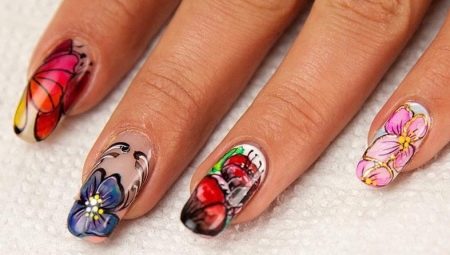
Watercolor painting of nails is one of the leading trends in modern nail art. Such a manicure is expensive, it fascinates, delights and does not allow you to take your eyes off. Since opinions about materials and the technique itself are contradictory today, it is worthwhile to dwell on this topic in detail and indicate its nuances.
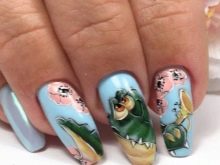
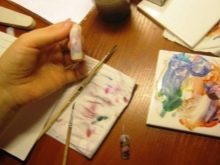
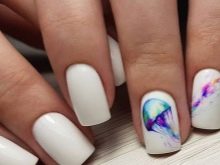
Materials and tools
Aquarelle design is called because it looks like artistic watercolors. These are the same halftones, lightness and translucency of paints, the use of a thinned consistency and a slight spreading effect. But contrary to the prevailing opinion, they do not use children's paints at all, but artistic watercolors. They differ in composition and form of release, and also softly lay on the work surface.
However, not all such pigments are applied to the nail so that another layer can be applied on top of one layer. Therefore, you need to thoroughly approach the choice of materials for watercolor design.
They paint on the nails with special manicure brushes. As a rule, they are very thin, differing in length and thickness. For example, a brush size can be not only zero, but also marked with two zeros.
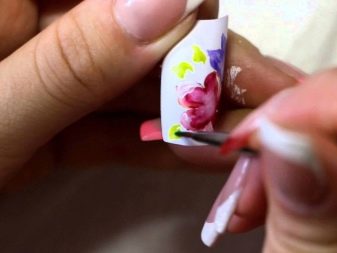
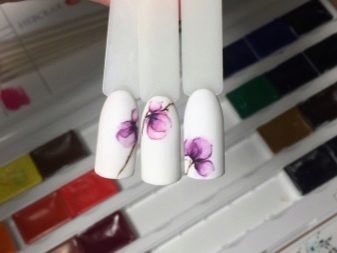
Watercolors are diluted with plain cold water, and therefore there are usually no problems with consistency in work. In the same way as when working with a paper sheet, a palette is used to dilute paints, obtain the necessary tones, and color overlay is performed. In addition, in the work, you can use acrylic paints, which also provide for dilution with water.However, they are distinguished by the nuance that after drying they cannot be removed from the brush, and therefore in the process of work you will have to make sure that the brush does not dry out.
If one tool is changed to another when it is necessary to select a tool of a different thickness, you will have to rinse out the used brush immediately. In addition to watercolors and acrylic paints, some masters can use diluted gel polish for this technique. It has to be diluted because the gel polish itself has a thick consistency for the drawing. You can use top or cleanser as a thinning agent.
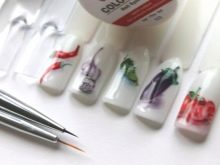
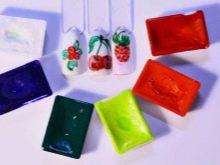
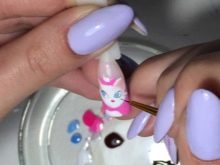
Background preparation features
A watercolor design is carried out on a prepared substrate, working with gel polish. Since coatings of this type have their own characteristics in the application technology, initially a background is created under the drawing, following all the rules for its layer-by-layer execution. It is he who will be a kind of canvas for design. In work, you will have to use a drying lamp, without which the used compounds will not dry.
First, prepare the nail, remove the cuticle and pterygium around it, give the desired shape, clean out all unnecessary. After that, the gloss is removed from the nail plate itself. After that, a layer of base, pigment and top is applied, each of them is dried immediately after application in a special lamp. After the top is dried, the surface under the pattern is buffed (processed with a soft grinder) to obtain a slightly rough surface. Then you can paint on it with water-based paints.
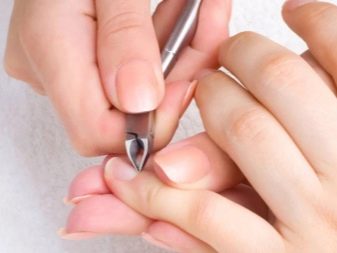

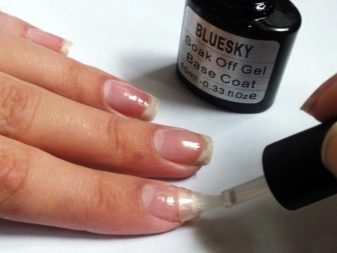
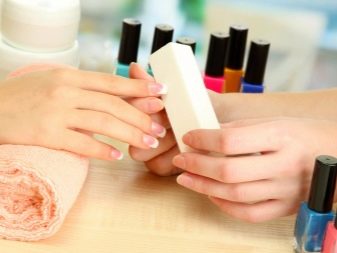
How to draw?
You do not need to wet anything additionally, the watercolor effect is achieved due to the lightness of the texture of the paints themselves. They can immediately fill the base of the future drawing, using a very light pigment, well diluted with water. Due to the liquid consistency, the paint will fall on the background with a soft transition of the degree of intensity. You can highlight some areas, try to shade the desired areas in some places.
In fact, the work resembles the work of an artist, except in a reduced format. Gradually, colors set off the necessary areas, paint on penumbra, highlight the necessary parts of the picture, some work out more, others are left blurry. It should be borne in mind that the paint will dry out very quickly during work, because it will be diluted with a tiny amount of water. Therefore, for the effect of a smooth flow from one color to another, you have to work quickly.
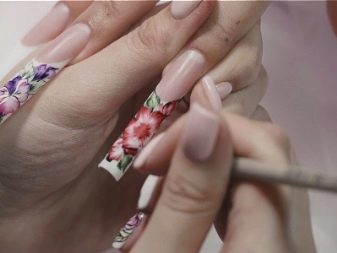
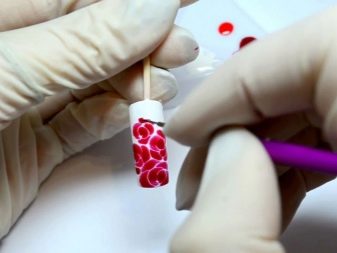
To make the desired image more beautiful, it will be useful to use the finished picture. Looking at it, it will be easier to see where and what is worth emphasizing with specific shades of the paints used. The method of work is notable for the fact that paints can be mixed with each other, getting new shades and halftones. As a rule, such drawings are not overloaded with the number of layers, they are only made brighter by drawing a specific part of the image.
When it is necessary to highlight any elements of the picture, the paints are mixed with white pigment. At the same time, white can dominate some of the tones used, since this can create an effect of lightness. However, do not whiten the texture too much: we must not forget about the translucency of the shades used.
You can add bright spots directly to the nail, helping them to spread with a brush to the desired place in the drawing.
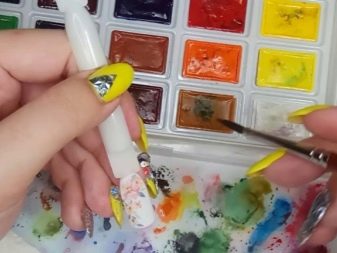
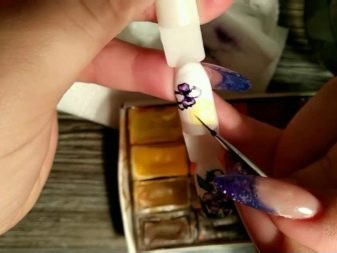
Brushes at work are changed as needed. The more area you need to paint with them, the thicker the brush can be. At the end, not everything is emphasized, but only some of the contours and elements of the picture, thereby leaving it lightness and translucency. It is worth considering that the smaller the stroke and the thinner the outline of the line, the more similar the watercolor effect will be.
It is also important to take into account the need to shade the background, for which more water is added to the paint used. This technique will enhance the watercolor effect on accent nails.Carrying out the contours in some places of the drawing, they try to draw less water on the brush. To do this, they use special soft brushes designed for watercolors.
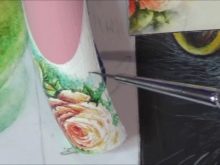
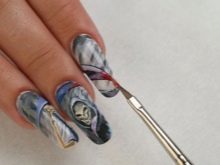

To keep the lines straight and confident, the brush must be positioned perpendicular to the nail.
There are many ways to paint watercolor painting. Sometimes the master makes an ordinary blot on the accent nail, and after it dries, he paints on its contours, for example, in the form of petals, thereby creating a beautiful flower. In addition, you can perform a preliminary sketch of the future drawing, displaying approximate contours. The base is filled with a gradual overlay of color and shades. After that, for a stroke, intermittent lines are sometimes applied to the edges of the print, often underlining the contour with several tones in addition to black.
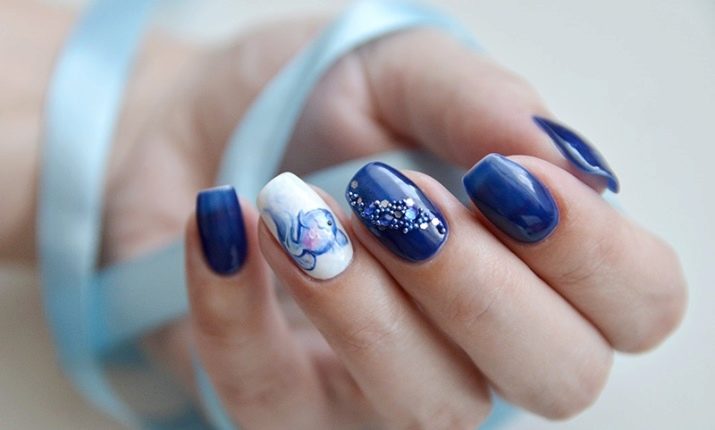

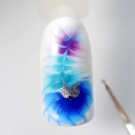
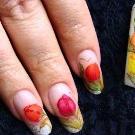
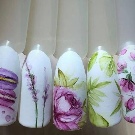
How to seal?
They close the design using a certain technology. However, first you need to wait for the drawing applied to the nail with watercolors or acrylics to dry completely. Otherwise, it will smudge when the sealant is applied.
You can overlap the design with a rubber top or a special two-in-one base-top.
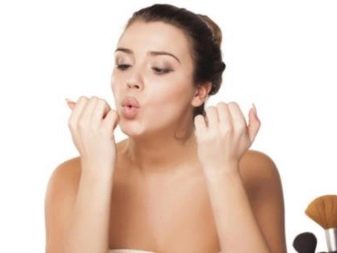
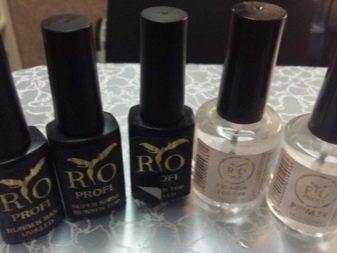
There is one drawback in the method of using a rubber top. After they overlap the design, they will have to apply a regular top over it to give the surface a glossy effect. If the "two in one" option is used, one overlapping layer is sufficient with its obligatory drying in a special lamp. This material is convenient in that it very reliably seals all layers of the coating, and therefore there will be no need to correct the plate during the entire time that the manicure decorates women's hands. After the sealing layer is dried in the lamp, it remains to remove the dispersion layer.
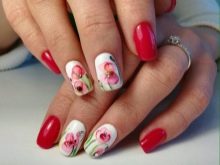
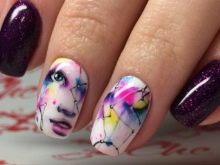
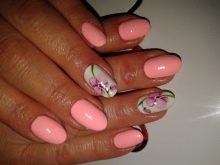
Expert advice
For beginners who decided to get acquainted with an interesting watercolor design technique, you need to listen to the main recommendations of the masters in the field of nail art.
- Using watercolor in the technique, it is important to take into account that it needs a matte finish. It will roll off the gloss regardless of its consistency and the manufacturer.
- Using acrylic paints or gel polish, you can ignore the type of varnish used for the substrate. In order to perform the design without hindrance, in this case it is enough to remove the dispersion sticky layer from the working background.
- The color of the substrate is preferably white or light. Dark and bright foundation tones will distort the beauty of the painting and spoil the watercolor effect.
- When performing drawings in wet technique, you need to add more water to the paint, and the strokes themselves should spread slightly, shimmering from one tone to another, which is possible only when the paint has not yet dried.
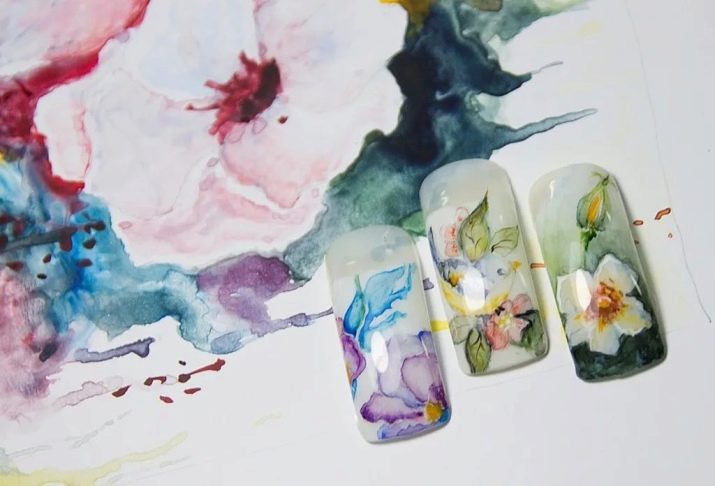

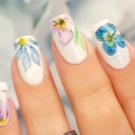
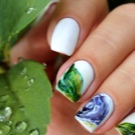
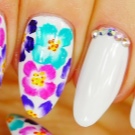
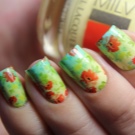
- If correction is necessary, wash out the paint. To do this, use a semi-dry brush and take in the excess intensity of the pigment with its nap. The same technique can be used to correct the flaws in the work.
- You can use the washing technique, in which one layer is applied to another with a short drying in a lamp (2 seconds each). This way you can gain brightness in certain places of a certain element of the image.
- To complete your first designs more beautifully, you can focus on the examples of experienced craftsmen, following their video tutorials step by step every moment of drawing a watercolor painting.
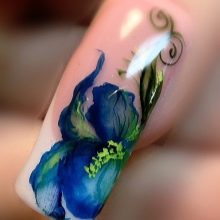
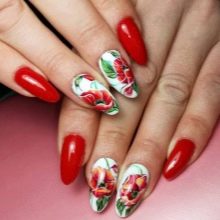
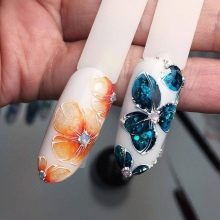
For information on how to draw beautiful abstract roses on nails using the avarice painting technique, see the video below.








